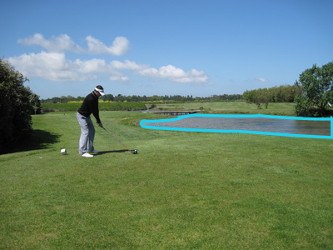
Hazard:
A hazard in golf refers to any obstacle or area on the golf course that poses a challenge or risk to the golfer. Hazards can be found in various forms, including both natural and man-made obstacles. Understanding the different types of hazards and how to navigate them is crucial for any golfer looking to improve their game. Let's explore some common hazards found on golf courses:
- Bunkers: Bunkers are shallow sand traps strategically placed on the golf course. They are usually located near the fairways or greens. When a golfer's ball lands in a bunker, it adds difficulty to the shot as the sandy surface makes it challenging to control the ball. Proper technique and skill are required to execute shots from bunkers effectively.
- Water Hazards: Water hazards are areas of water, such as ponds, lakes, streams, or even just shallow depressions, located on the golf course. If a golfer's ball lands in a water hazard, it results in a penalty stroke. Water hazards require careful shot selection and accurate execution to avoid losing strokes.
- Out of Bounds: Out of bounds refers to areas outside the defined boundaries of the golf course where play is not permitted. This could include neighboring properties, roads, or designated out of bounds markers. If a golfer's ball goes out of bounds, they must take a penalty stroke and replay the shot from the original position. Accuracy and control are essential to avoid out of bounds penalties.
- Trees and Rough: Trees and rough areas are natural hazards that can be found on most golf courses. Trees lining fairways or strategically placed throughout the course can be challenging obstacles for golfers. Balls that land in these areas often require creative shot-making abilities to recover and get back on track.
- Unfavorable Lies: Unfavorable lies encompass various conditions where the golf ball does not rest in an ideal position. This includes situations such as a ball settling in a divot (a depression made by a previous shot) or ending up on a slope. These lies require careful consideration and adjustments to your shot, as they can affect the trajectory and control of the ball.
Golfers must be aware of these hazards and adjust their game accordingly. Here are a few tips to navigate hazards effectively:
- Assess the Situation: Take a moment to carefully evaluate the hazard and its surrounding conditions. Consider the distance, potential risks, and possible shot options.
- Choose the Right Club: Selecting the appropriate club for the shot is essential. Depending on the distance to the hazard and desired outcome, you may need to use a different club than usual.
- Adopt a Safe Strategy: Sometimes, the best strategy is to play it safe and avoid the hazard altogether. Take the necessary precautions and aim for a safer target area.
- Practice Hazard Shots: Spend time practicing shots that specifically target hazards like bunkers and water. This will improve your confidence and skill when faced with similar situations on the course.
- Stay Calm and Focused: Hazards can be mentally challenging. Stay calm, maintain focus, and trust your abilities to overcome the obstacle.
By understanding the different hazards on a golf course and implementing these tips, golfers can effectively navigate these challenges and improve their overall game.





